Siamese–Vietnamese War (1831–1834)
The Siamese–Vietnamese War of 1831–1834 (Thai: อานามสยามยุทธ (พ.ศ. 2374 – พ.ศ. 2377), Vietnamese: Chiến tranh Việt–Xiêm (1831–1834)), also known as the Siamese-Cambodian War of 1831–1834, was sparked by a Siamese invasion force under General Bodindecha that was attempting to conquer Cambodia and southern Vietnam. After initial success and the defeat of the Khmer Army at the Battle of Kompong Cham in 1832, the Siamese advance was repelled in southern Vietnam in 1833 by the military forces of the Nguyễn dynasty. Upon the outbreak of a general uprising in Cambodia and Laos, the Siamese withdrew, and Vietnam was left in control of Cambodia.[1][2][3][4]
| Siamese–Vietnamese War (1831–1834) | |||||||
|---|---|---|---|---|---|---|---|
| Part of Siamese–Vietnamese Wars and Vietnamese invasions of Cambodia | |||||||
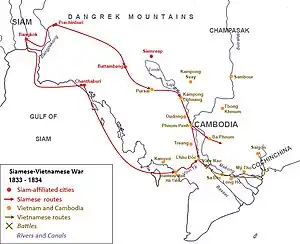 Red represents Siamese army routes. Yellow represents Vietnam and Cambodia. | |||||||
| |||||||
| Belligerents | |||||||
| Nguyen dynasty (Vietnam) |
| ||||||
| Commanders and leaders | |||||||
|
Emperor Minh Mạng Trương Minh Giảng Nguyễn Xuân Tống Phước Lương Phạm Hữu Tâm { Lê Văn Thụy Phạm Văn Điển Nguyễn Văn Xuân Trương Phúc Đĩnh |
| ||||||
| Units involved | |||||||
| Vietnamese Army |
| ||||||
| Strength | |||||||
|
~13,000 troops ~35-40 warships |
~50,000 troops ~100 warships | ||||||
| Casualties and losses | |||||||
| unknown | unknown | ||||||
Background
Internal and Interstate conflicts in Cambodia, Siam and Vietnam
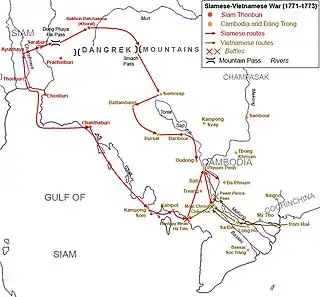
Since the eventual end of Khmer empire in the fifteenth century, post-Angkorian Cambodia had been more or less under aggression by neighboring Siamese Ayutthaya kingdom. In the seventeenth century, Vietnam, led by the Nguyen Lords of Đàng Trong, expanded to the south into Mekong delta of Cochinchina, which had been Cambodian territories, in the process known as Nam tiến.[5] Nguyen Lords exerted influence over Cambodia, bringing them into conflicts with Siam who also sought to control Cambodia. Dynastic factional conflicts in Cambodia aggravated the issue[6] as rival princely candidates usually sought supports from either Siam or Vietnam in their claims to Cambodian throne. In 1771, Siamese King Taksin of Thonburi sent troops to invade Cambodia in efforts to overthrow pro-Vietnamese King Ang Ton of Cambodia and to install his pro-Siamese candidate Ang Non.[7][8] Siamese invasion did not achieve goal as the Nguyen Lord Nguyễn Phúc Thuần sent Vietnamese forces to repel the Siamese from Cambodia in 1772.[7][8] Tây Sơn uprising toppled the rule of the Nguyen Lord in Vietnam. With Vietnamese assistance dwindling, Ang Ton decided to reconcile with his rival Ang Non.[7] Ang Ton abdicated in 1775 in favor of Ang Non,[7] who became the new pro-Siamese king of Cambodia. Ang Ton soon died in 1777. Another turn of event occurred in 1778 when Chauvea Tolaha Mou, the Cambodian Prime Minister, rebelled against Ang Non with support from the Nguyen Lord Nguyễn Phúc Ánh, who was fighting the Tay Son at the same time. Nguyễn Phúc Ánh sent Vietnamese forces to defeat and kill Ang Non in 1779. Tolaha Mou installed Ang Eng the seven-year-old[9] son of Ang Ton as his puppet king. Taksin was enraged as his pro-Siamese candidate was murdered by the pro-Vietnamese faction. In late 1781, Taksin sent Siamese forces under Chaophraya Chakri into Cambodia.[10] However, a rebellion happened at home in Thonburi,[11] prompting Chakri to broker a peace with Nguyễn Phúc Ánh in order to return to pacify political upheaval in Thonburi in 1782.[8] Chaophraya Chakri assumed power and ascended the throne as King Rama I of Rattanakosin Kingdom, founding the Chakri dynasty of Siam.
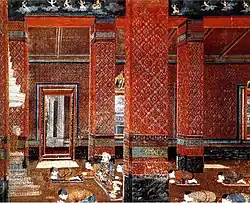
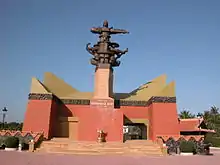
Nguyễn Phúc Ánh was ousted from his base at Saigon by the Tây Sơn in 1783.[8] Defeated, Nguyễn Phúc Ánh took refuge in Bangkok[8] where he was well-received by the Siamese court, partly due to the preceding peace negotiations in Cambodia in 1782. Also in 1783, Oknha Yumreach Baen, a pro-Siamese Cambodian nobleman, managed to seize power from Tolaha Mou but the ensuing chaos and upheaval in Cambodia obliged Yumreach Bean to take the young king Ang Eng to Bangkok to be under Siamese custody. King Rama I of Siam sent Siamese riparian fleet down the Mekong in 1784 in efforts to restore Nguyễn Phúc Ánh but was utterly defeated by Tây Sơn navy under Nguyễn Huệ in the Battle of Rạch Gầm-Xoài Mút.[8] The Siamese king appointed Yumreach Baen as Chaophraya Aphaiphubet to be prospective head pro-Siamese minister in Cambodia, though Cambodia continued to be technically under Vietnamese domination. In 1787, Nguyễn Phúc Ánh left Bangkok to successfully reconquer Saigon in 1788 and to reclaim his polity from the Tây Sơn with French assistance.[2] According to Thai chronicles, Nguyễn Phúc Ánh sent tributes to Bangkok during his stay in Saigon.[9] In 1789, Aphaiphubet finally defeated the rival pro-Vietnamese faction and took control of Cambodia. In 1794, King Rama I allowed Ang Eng to return to Cambodia to assume personal rule[9][11] but also carved northwestern Cambodia, including the srok of Battambang and Siemreap, for Aphaiphubet to govern separately[12] under Siamese direct rule. King Ang Eng of Cambodia died prematurely in 1796 with all of his four sons: Ang Chan, Ang Snguon, Ang Em and Ang Duong, were considered by Siamese court to be too young to rule. Nguyễn Phúc Ánh eventually reclaimed and unified Vietnam, proclaiming himself Emperor Gia Long of the Nguyen dynasty in 1802.
Siamese–Vietnamese conflicts over Cambodia in 1811–1813
In 1806, Ang Chan the eldest son of Ang Eng, who had been held custody in Bangkok being a young Cambodian prince, was finally crowned as the new king of Cambodia by King Rama I and was allowed to return to Cambodia to rule.[8][9] However, Ang Chan grew resented of Siamese influence over Cambodia and eventually became pro-Vietnamese.[2][6][11] On his coronation, Ang Chan also received recognition state seal from Gia Long and reciprocated with friendly gesture.[13] When Chaophraya Aphiphubet Baen, the Siam-appointed governor of Battambang, died in 1809, another pro-Siamese governor was appointed, upsetting Ang Chan who expected Northwestern Cambodia to be returned to him.[9][11] Siam-appointed governors of Battambang would be thorn in the side for Ang Chan. Ang Chan did not attend the funeral of Siamese King Rama I in 1809 and sent his younger brothers Prince Ang Snguon and Prince Ang Em to Bangkok in his stead.[13] The new Siamese king Rama II then made Prince Ang Snguon the Uprayorach (viceroy) and Prince Ang Em the Ouparach (deputy viceroy), without consulting Chan,[9] thus making these two princes to form a new pro-Siamese faction in Cambodia. Also in 1809, the Burmese invaded Phuket and King Rama II asked for Ang Chan to contribute forces as vassal kingdoms were expected to provide military assistance. However, Ang Chan ignored this request. Two pro-Siamese Cambodian ministers, Chakrey Pen and Kralahom Muong, acted on their own to gather Cambodian forces to be sent to Siam without Ang Chan's consent. Ang Chan considered this action to be a sedition and executed these two officials.[13] The Cambodian court became again polarized into Siamese and Vietnamese factions.[9]
The pro-Siamese prince Ang Snguon eventually rebelled against his pro-Vietnamese brother Ang Chan in 1811.[2] Ang Snguon left the Cambodian royal city of Oudong to gather his pro-Siamese supporters at Pursat.[11] Ang Chan requested military aid from the Vietnamese. Nguyễn Văn Thoại was sent to bring Vietnamese fleet to take defensive position at Longvek against Siamese attacks. Siamese court, in turn, sent Chaophraya Yommaraj Noi to lead an army of 5,000 men[13] into Cambodia in 1812 to support Ang Snguon. Panicked, King Ang Chan, escorted by Nguyễn Văn Thoại, fled from Oudong to take refuge at Saigon where he was accommodated by the Vietnamese. Princes Ang Em and Ang Duong, Chan's younger brothers, chose to join the Siamese side instead and went to join their brother Ang Snguon.[11] Yommaraj Noi, the Siamese commander, took control but found himself unprepared for long-term occupation of Cambodia. Yommaraj Noi then destroyed and burnt down Cambodian cities of Oudong, Phnom Penh[2] and returned to Bangkok with Cambodian princes Ang Snguon, Ang Em and Ang Duong. The Siamese also deported thousands of Cambodians to the Siam-occupied Northwestern Cambodia.[2][11]
Both Siam and Vietnam avoided direct confrontations during the crisis of 1811–1813. Simultaneously as Siamese army was invading Cambodia, the Siamese court sent a mission to Gia Long at Huế in 1812, explaining that Siamese expedition into Cambodia was of good intention to restore peace while blaming Ang Chan for the troubles at the same time.[13] Gia Long assumed friendly pretension but put the blame on Ang Snguon instead. Through his reign, Gia Long maintained amicable relations towards Siam but geopolitical dilemma would soon cause Siamese–Vietnamese relations to sour. Cambodia moved closer towards Vietnamese domination. Siam was hesitant to actively compete with Vietnam over Cambodia due to prospective Burmese threat was still looming. In 1813, Gia Long assigned Lê Văn Duyệt, who had just been appointed as the governor of Saigon in 1812,[14] to lead the Vietnamese army of 13,000 men[6] to escort Ang Chan back to Cambodia with Siamese representatives as witnesses. Upon seeing the wrecked ruins of his royal city burnt to the grounds by the Siamese, Ang Chan reportedly cried in tears.[13] Lê Văn Duyệt oversaw military defenses in Cambodia, constructing a new royal citadel for Ang Chan at Phnom Penh called Banteay Keav and another citadel at Lvea Aem. Ang Chan chose to reside at Phnom Penh rather than Oudong owing to its riverside position being accessible to Vietnamese protection navy.[11] Nguyễn Văn Thoại was appointed as bảo hộ[14] or Protector of Cambodia – technically Vietnamese representative minister in Cambodia.
Cambodia under Vietnamese domination: 1813–1833
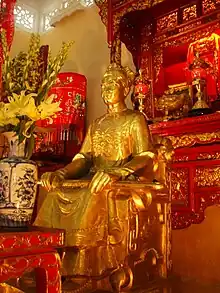
Lê Văn Duyệt (called Ong Ta Kun in Thai and Cambodian chronicles) was appointed as Gia Định Thành[14] or governor of Saigon citadel in 1812, which acted as the viceroy of Cochinchina or Southern Vietnam and also had authorities over Cambodia. With appointment of Nguyễn Văn Thoại as bảo hộ Chân Lạp or Protector of Cambodia in 1813, Cambodia became Vietnamese protectorate.[6] Lê Văn Duyệt also built a Vietnamese shrine for Emperor Gia Long at Chroy Changvar, the land opposite of Phnom Penh on the river. Twice a month, Cambodian king Ang Chan, along with his Cambodian officials, would dress in Vietnamese costumes and worship Nguyễn Hữu Cảnh (a Vietnamese commander who conquered Cambodia in 1700)[8] at the shrine. In 1815, at suggestion of Nguyễn Văn Thoại,[13] Ang Chan sent Cambodian forces led by Samdech Chauponhea Tey[13] to attack Battambang and reclaim Northwestern Cambodia from Siam. Samdech Tey, however, was repelled by Ros, the pro-Siamese governor of Battambang who was a son of Aphaiphubet Baen. This incident led to another round of Siamese–Vietnamese diplomatic crisis as Bangkok accused Nguyễn Văn Thoại of instigating this attack. Samdech Tey became the scapegoat as Vietnam put the blame on his belligerent actions and put Samdech Tey under pretensive investigation to please Siam.[13]
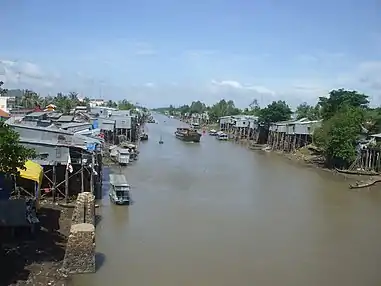
In 1819, Gia Long came up with the construction project of Vĩnh Tế canal that would connect Châu Đốc with Hà Tiên.[15] Nguyễn Văn Thoại was put in charge of the project with dedicative participation from King Ang Chan of Cambodia as Cambodian people were conscripted to labor works on the canal supervised by the Vietnamese. Vietnamese overseers treated Cambodian workers, who were subjected to poor working conditions, harshly.[13] In 1820, Cambodian workers arose against Vietnam led by Snang Ke.[13] The rebellion of Snang Ke was soon crushed by Vietnam. Gia Long died in early 1820, to be succeeded by his son Minh Mạng. Minh Mạng initially maintained neutral attitude towards Siam and also took cautious approach on his powerful mandarin Lê Văn Duyệt, who was appointed as the governor of Saigon for the second time, in the same year. Also in 1820, a Cambodian Buddhist monk also named Ke declared himself Neak Sel or holy man and rebelled against Vietnam.[13] Neak Sel Ke was eventually defeated by Lê Văn Duyệt. Siam took construction of the Vĩnh Tế canal with great alarm as Siam suspected the canal would facilitate movement of Vietnamese fleets into the Gulf of Siam, directly threatening Bangkok. In response, King Rama II then ordered his son Prince Chetsadabodin to supervise the construction of the Phisuea Samut or Samut Prakarn Fort in 1822 in defense against possible Vietnamese seaborne incursion.
.jpg.webp)
Pro-Siamese princes Ang Snguon, Ang Em and Ang Duong, half-brothers of Ang Chan, resided in Wang Chao Khamen or Cambodian quarters in Bangkok established since the times of Ang Eng.[16] Ang Snguon died in 1822, leaving Ang Em and Ang Duong as living pro-Siamese candidates. Neak Neang Tep, daughter of Chaophraya Aphaiphubet Baen the Siam-appointed governor of Battambang who died in 1809, was one of the consorts of King Ang Chan and bore him a daughter named Princess Ang Pen. Neak Neang Tep and her brother Preah Angkeo Ma represented the remaining pro-Siamese faction in Cambodian court.[13] In 1829, Ang Chan sent Preah Angkeo Ma to deliver tributes to Siam – a purely symbolic gesture just to keep Siamese aggression at bay. Angkeo Ma, however, secretly handed a letter to King Rama III or King Nangklao of Siam, urging the Siamese king to attack Cambodia to topple Vietnamese influence.[13] Siam was still unresponsive but Angkeo Ma's confidential maneuver was exposed to the Vietnamese. The Vietnamese ordered the arrest of Samdech Ma but he fled to Siam. Also in 1832, Oknha Surkealok Kas the chauvay srok or governor of Pursat, who was pro-Siamese, rebelled against Ang Chan and fled to Siam with majority of Cambodian population in Pursat.[13]
Anouvong's Lao rebellion
In the eighteenth century, the Lao Kingdom of Lanxang fragmented into three separate kingdoms of Luang Prabang, Vientiane and Champasak, with Muang Phuan, an another polity, under periodic Vietnamese control. In 1778–1779, Siamese invading armies conquered all three Lao kingdoms to become tributary states under Siamese domination. Royal family of Vientiane, including the young prince Anouvong, were taken to Bangkok as hostages. Anouvong grew up in Siamese court and was allowed to return to Vientiane as a prince in 1795, becoming the King of Vientiane himself in 1805. Prince Anouvong took Muang Phuan by force in 1799, forcing the ruler of Muang Phuan to accept the authority of Vientiane but, through arrangements by Gia Long in 1802, Muang Phuan was given to Luang Prabang.[17] However, Anouvong again sought to dethrone Chao Noy the ruler of Muang Phuan, who was married to a female relative of Anouvong.[17] Chao Noy eventually accepted Anouvong's authority but, at the same, pleaded for Vietnamese aid[17] and held grudges against Anouvong.
In 1824, King Rama II of Siam died and Anouvong traveled to Bangkok to attend the royal funeral but faced derogatory treatment.[17] Also in 1824, the Siamese court ordered the Sak Lek or conscription tattooing in Laos, an unprecedented policy that oppressed Lao people and disregarded Anouvong's authorities.[17] Given the wrong impression that the British would attack Bangkok,[17] Anouvong took this false opportunity to march his Lao armies in 1826–1827 to stop the Sak Lek and to threaten Bangkok, seizing Nakhon Ratchasima and Saraburi. Anouvong, however, was repelled by Siamese counter-offensive forces. With defeat imminent, Anouvong fled from Vientiane to Vietnamese Nghệ An Province, seeking protection under Vietnam. Lê Văn Duyệt suggested belligerent retaliation against Siam but Minh Mạng preferred peaceful means.[17] Minh Mạng sent Phan Văn Thúy to escort Anouvong back to Vientiane in 1828 to negotiate with Siamese officials there.[17] According to Thai chronicles, the Vietnamese envoy spoke: "Siam is like the father. Vietnam is like the mother. When the father is angry over the child. The mother should bring the child to apologize."[18] Anouvong, however, unexpectedly arose and killed the unprepared Siamese officials in Vientiane. With situation spiraled out of hand, Minh Mạng sent another Vietnamese mission to Nakhon Phanom to propose peace terms. Chaophraya Ratchasuphawadi (later Chaophraya Bodindecha) the Siamese commander, however, was convinced that Vietnam was behind this deadly ambush on the Siamese at Vientiane. Ratchasuphawadi held a fake banquet for Vietnamese envoys in Nakhon Phanom, where Siamese forces massacred nearly all of the Vietnamese envoys there. Shocked, Minh Mạng sent a mission to Bangkok in 1829 to demand justice for the incident but Bangkok was not cooperative.
When the Siamese armies invaded Laos in search for Anouvong, Chao Noy the ruler of Muang Phuan asked for Vietnamese protection. Minh Mạng was poised to annex Muang Phuan into Vietnamese rule by transforming Muang Phuan into Trấn Ninh (鎮寧) Province. When Anouvong was defeated again in 1828 and fled to Xiangkhouang, Chao Noy the ruler of Muang Phuan, a former vassal to Anouvong that later became a vassal of Vietnam,[19] revealed the whereabouts of Anouvong to Bodindecha, which led to the capture of Anouvong.[20] Anouvong was eventually captured and encaged, transported as a prisoner to Bangkok in 1828. At Bangkok, Anouvong and his family were subjected to tortures and public humiliation. Anouvong died in early 1829. The kingdom of Vientiane was dissolved as the royal city of Vientiane itself was mostly destroyed and burnt to the grounds.[20] Minh Mạng sent Tạ Quang Cự[21] to occupy Muang Phuan and to assist Chao Noy but soon realized that Chao Noy had switched loyalty to Siam. When Minh Mạng learnt that Chao Noy had cooperated with the Siamese in the downfall of Anouvong, the Vietnamese emperor summoned Chao Noy to Huế for explanation[20] but Chao Noy had become defiant to Vietnam, refusing to go. Tạ Quang Cự then arrested Chao Noy and brought him to Huế, where Chao Noy was executed by slow slicing in 1829 by the orders of Minh Mạng. Muang Phuan–Xiangkhouang then came under direct Vietnamese control as the Trấn Ninh Province.[20] Tạ Quang Cự was appointed as the governor of Nghệ An and Hà Tĩnh[21] – Vietnam's frontline area against Laos-Siam. Minh Mạng also appointed Chao San, a distant relative of Chao Noy, as the puppet ruler of Muang Phuan.[20]
Lê Văn Khôi Rebellion
Warlord Lê Văn Duyệt held the position of Gia Định Thành or governor of Saigon from 1820 to his death in 1832[22] and, during his tenure, had been the most powerful minister of Southern Vietnam, also holding influence over Cambodia. Under his rule, Lê Văn Duyệt allowed Chinese immigrants to flourish in their trades and Christian Southern Vietnamese to enjoy their religious freedom.[22] He was popular and was the personification of Southern Vietnam itself.[22] This, however, conflicted with Minh Mạng's staunch Confucianist policies. Minh Mạng considered Southern Vietnam to be an unruly autonomous region where illegal opium imports by Chinese immigrants and Christianity were allowed and tolerated.[22] Minh Mạng then sought to dismantle this autonomous regional apparatus. In 1831, Minh Mạng appointed his own officials Nguyễn Văn Quế as governor of Gia Định (Saigon) province as a part of his administrative reforms to reorganize Vietnam into tỉnh or provinces and also appointed Bạch Xuân Nguyên as the attorney of Saigon.[2][14][22] Lê Văn Duyệt finally died in 1832 and this gave pretext for Minh Mạng to further undo Lê Văn Duyệt's legacies.[23] The autonomous position of Gia Định Thành was abolished in favor of centrally-appointed provincial governors. Minh Mạng prohibited Christianity in January 1833 and Western Catholic priests, missionaries and Vietnamese Christians were arrested and persecuted.[22][24] French priests, including Father Régéreau and Jean-Louis Taberd, fled to Siam.[24] Bạch Xuân Nguyên reported to Minh Mạng at Huế that the recently-deceased Lê Văn Duyệt had been corrupted and abusive of his powers.[22] Minh Mạng then instituted posthumous punishments for Lê Văn Duyệt by digging his dead body out of his grave to be canned. Three generations of Lê Văn Duyệt's family were executed and his followers were arrested and punished[22] in large-scale political purge of Southern Vietnam.
Lê Văn Khôi, adopted son of Lê Văn Duyệt, arose in rebellion against Minh Mạng in April 1833. The rebels murdered Minh Mạng's officials including Nguyễn Văn Quế and Bạch Xuân Nguyên the governors of Saigon. Lê Văn Khôi rebels seized control of Saigon and gained a large number of followers in Southern Vietnam, especially the Christians.[2][23] In 1833, Lê Đại Cương (known in Thai chronicles and Ong Chan Bia) had been holding the position of tổng đốc or governor of An Giang and Hà Tiên provinces[14] and was also bảo hộ or Protector of Cambodia, Vietnamese head minister in Cambodia. Lê Đại Cương and other Minh Mạng's commanders attempted to retake Saigon but was utterly defeated by the rebels as Lê Đại Cương himself had to take refuge in Cambodia. Lê Văn Khôi quickly took control of all six Southern Vietnamese provinces including Biên Hòa, Gia Định (Saigon), Định Tường (Mỹ Tho), Vĩnh Long (Long Hồ), An Giang (Châu Đốc) and Hà Tiên.[24] With initial setbacks, Minh Mạng assigned a whole new troupe of commanders led by Tống Phước Lương, including other commanders such as Nguyễn Xuân and Trương Minh Giảng, to put down Lê Văn Khôi's rebellion. Tống Phước Lương was successful against the rebels, reconquering all of Southern Vietnam for Minh Mạng by late 1833 except for the Saigon citadel itself where Lê Văn Khôi stood.
Nearly defeated, Lê Văn Khôi attempted to enlist Siamese help by sending deputations to Siam but they were unsuccessful as they were intercepted, revealing a letter written by Lê Văn Khôi to Siamese king Rama III to ask for military aid.[24] Perhaps informed by the fleeing French priests, Siam became known about the upheavals in Southern Vietnam. King Rama III was to capitalize this opportunity to dismantle Vietnamese influence in Cambodia and to possibly take control of Southern Vietnam. Siam, by the 1830s, considered Vietnam to be a geopolitical rival rather than an established ally. In the words of Thai chronicles; "When Ong Chan rebelled, Vietnam supported him. When Anou rebelled, Vietnam also supported him and escorted him back to restore. They also do this in Cambodia, restricting Thai territories and boosting themselves as Duc Hoang De."[18] The Siamese king did not like that Vietnamese rulers styled themselves as Hoàng đế or emperors. Rama III initiated the Siamese campaign to bring Prince Ang Em to the Cambodian throne and to take Saigon.[2][25][26]
Siamese preparations
King Rama III arranged the Siamese forces into the following routes:
- Chao Phraya Bodindecha would lead[27][28] a land army of 40,000 men to bring Prince Ang Em and Ang Duong to Cambodia and to proceed to take Saigon.
- Chao Phraya Phraklang would lead a galley fleet of 10,000 men to attack Hà Tiên and to converge with the land army at Saigon.
- Phra Mahathep Pom and Phra Ratchawarin Kham would attack Xiangkhouang and Nghệ An Province through Khorat Plateau and Laos.[2][13]
Military campaigns
Siamese invasion of Cambodia, Hà Tiên, and An Giang
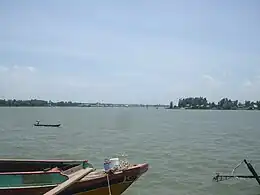
.jpg.webp)
All three Siamese armies left Bangkok on the same day on November 23, 1833. The main column of Chao Phraya Bodindecha marched from Battambang to seize Pursat and Kampong Chhnang. King Ang Chan of Cambodia, upon hearing news of Siamese invasion, organized Cambodian forces to resist the Siamese. However, Cambodia was able to muster a troop of only 300 men in short period of time. Oknha Chakrey Long led the Cambodian army against Siamese vanguard forces of 5,000 men in the Battle of Kampong Cham in December 1833. Chakrey Long was defeated and fled to Ba Phnum.[13] After the defeat of Chakrey Long, King Ang Chan and his court fled on December 31 to Long Hồ, in Vĩnh Long Province. Bodindecha then marched his armies through Cambodia without further resistances.[13] The Siamese general left Princes Ang Em and Ang Duong to take control in Phnom Penh and proceeded to Ba Phnum.
The fleet of Phraklang reached Hà Tiên in January 1834. The Vietnamese, who had been preoccupied with Lê Văn Khôi's rebellion, were caught unprepared, and the Siamese quickly took Hà Tiên.[29] Phraklang then sailed his fleet upstream the Vĩnh Tế Canal and also quickly took Châu Đốc in the An Giang Province. Bodindecha, who had reached Ba Phnum, sent his brother-in-law Chao Phraya Nakhon Ratchasima to bring 7,000 men eastwards through Ba Phnum district directly to Saigon Bodindecha himself joined Phraklang at Châu Đốc. Emperor Minh Mạng then ordered Trương Minh Giảng and Nguyễn Xuân to counter the Siamese offensives in An Giang.[2][30][13]
Battle of Vàm Nao
To reach Saigon from Châu Đốc, the Siamese fleet had to cross from the Bassac River to the Mekong via the Vàm Nao Canal. Chao Phraya Bodindecha merged his army into Phraklang's fleet and the massive Siamese fleet proceeded along the Bassac River and reached the Vàm Nao Canal or Thuận Cảng Canal on January 21, 1834, where they met the Vietnamese fleet. The Battle of Vàm Nao ensued and continued for ten days. The Siamese initially prevailed. The Vietnamese retreated towards the Mekong and the Siamese pressed on the attack. Bodindecha ordered his fleet to disembark and attack the Vietnamese on land but was repelled by Vietnamese General Phạm Hữu Tâm. The admirals of Phraklang's fleet, however, refused to engage with the Vietnamese fleet. Phraklang himself had to board a small boat to encourage his admirals to attack but to no avail. Vietnamese reinforcements, including more than 100 battle junks, led by Tống Phước Lương, arrived and the overwhelming number of the Vietnamese engaged Bodindecha's armies. The Siamese were unable to withstand the Vietnamese, and both Bodindecha and Phraklang decided to retreat on January 31, 1834 or in February 1834.[2][13]
Siamese retreat and Vietnamese offensives
After the Battle of Vàm Nao, the Siamese retreated to Châu Đốc on February 2, 1834. Trương Minh Giảng capitalized on the victory by sending a fleet to follow the Siamese and attack Châu Đốc. Chao Phraya Bodindecha ordered the Siamese to fire upon the disembarking Vietnamese, which resulted in bodies piling on the river bank. Phraklang then retreated further to Hà Tiên through the Vĩnh Tế Canal and carried off the local population of Banteai Meas, Kampot, and Kampong Som to be resettled in Chanthaburi. The water of the Vĩnh Tế Canal was too shallow for the galleys to proceed.
Phraklang then ordered some of the galleys to be pulled by elephants to Kampot. However, the Cambodians revolted and murdered the mahouts, taking all of the elephants. As the Vietnamese kept attacking Châu Đốc, Bodindecha decided to abandon Châu Đốc, retreat from Cambodia to Chantaburi, and take along as much of the local population as he could find on the way back.[13]
Oknha Chakrey Long the Cambodian commander, who had earlier fled to Ba Phnum, organized Cambodian resistant forces with Oknha Yumreach Ho near Prey Veng. Chao Phraya Nakhon Ratchasima and Phraya Ratchanikul, who had led the Siamese troops from Ba Phnum eastward to Saigon, were attacked by Oknhas Chakrey Long and Yumreach Ho at Prey Veng and realized that the main Siamese forces had already retreated. Siamese commanders Nakhon Ratchasima and Ratchanikul returned to the Mekong but found that all boats to cross the river had vanished and so built a pontoon bridge to cross. Internal dissent caused some contingent commanders to leave the army group and marched northwards along the Mekong, where they were massacred. Chao Phraya Nakhon Ratchasima and Phraya Ratchanikul eventually crossed the Mekong and engaged the Cambodian insurgents. Chao Phraya Bodindecha ordered Chao Phraya Nakhon Ratchasima and Phraya Ratchanikul to retreat to Nakhon Ratchasima.
Trương Minh Giảng reconquered Châu Đốc and Hà Tiên. Bodindecha instructed Princes Ang Em and Ang Duong at Phnom Penh to destroy the citadel, burn the city, and march all inhabitants to Battambang. However, revolts against the Siamese invaders broke out in Phnom Penh and the rest of Cambodia under the co-ordinated leadership of two Khmer magistrates, Chakrey Long and Yumreach. All further hostile acts of Siam met massive resistance.[31] Bodindecha and the two princes then retreated towards Siam.[26] Bodindecha reached Pursat on February 15 and then retreated further to the Siamese-held Battambang.
In 1834, Viceroy Trương Minh Giảng and his vassal king, Ang Chan, returned to Phnom Penh. Vietnamese rule in Cambodia had been established.[2] King Ang Chan awarded Oknha Chakrey Long with the position of Chauvea Tolaha or Prime Minister and Oknha Yumreach Hu with the position of Samdach Chauponhea.
Northern Fronts
Phra Mahathep Pom and Phra Ratchawarin Kham reached their respective destinations in January 1834. Phra Mahathep Pom stationed at Nakhon Phanom and Phra Ratchawarin Kham at Nongkhai. Phra Mahathep Pom led a Siamese army to attack the Lao city of Mahaxay, which had been under Vietnamese rule. He then proceeded to attack Phu Thai communities of modern Savannakhet Province including Muang Pong, Muang Phalan and Muang Champhone. The Siamese relocated the Phu Thai people to settle in what is now Nakhon Phanom Province and the surrounding areas.[26]
Siamese conquest of Muang Phuan
After the execution of Chao Noy of Muang Phuan at Huế in 1829, Minh Mạng appointed Chao San, a prince of Phuan royal dynasty, as the new puppet ruler of Muang Phuan under Vietnamese control.[20] Muang Phuan had been under direct Vietnamese governance as the Trấn Ninh province. Phra Ratchawarin Kham and Phra Patumthewa the governor of Nongkhai sent secret messages to Chao San, urging him to defect to the Siamese side. Chao San, disillusioned with Vietnamese rule,[20] decided to join Siamese side. Phra Ratchawarin Kham led the Siamese army to capture Muang Phuan, defeating and massacring the Vietnamese occupying forces there. Vietnamese forces in Muang Phuan was left unsupported as Tạ Quang Cự the governor of the adjacent Nghệ An and Hà Tĩnh provinces was sent away to suppress the rebellion of Nông Văn Vân in the same year.[21]
Muang Phuan, as a tributary state to Siam, was too far from Siamese influence and was difficult to defend. Siam proposed that Muang Phuan and its people should be evacuated in order to avoid Vietnamese retaliation.[20] Chao San the ruler of Muang Phuan agreed to evacuate 4,000 families of his people across the Mekong to the west side.[20] However, they soon learned that Siam had intended to deport them further into Central Siam.[20] Siam dissolved the Kingdom of Muang Phuan altogether. Nearly all of the Phuan people of Muang Phuan were forcibly relocated[32] to Nan, Sukhothai, Uttaradit, and Phitsanulok Provinces, and Muang Phuan was left largely deserted. A recent study in 2015 found that some of the displaced Phuan people eventually reached as far as Banteay Meanchey and Battambang provinces of Cambodia, where they are misidentified as Liao (Lao) instead of Phuan. [33]
Aftermath and Prelude to 1841–1845 war
The Siamese armies had returned by May 1834. The Siamese retreat left Vietnam in full control of Cambodia. Vietnam, led by Trương Minh Giảng, established Nam Vang or Phnom Penh as headquarter. King Ang Chan of Cambodia died in January 1835. Ang Chan did not have a son but had four daughters; Ang Baen, Ang Mey, Ang Peou and Ang Sngon. Siam had Prince Ang Em, younger brother of Ang Chan, appointed as the governor of Battambang. With the Princes Ang Em and Ang Duong on the Siamese side, Trương Minh Giảng proposed to make Princess Ang Mey, Ang Chan's second daughter, the queen regnant of Cambodia. Princess Ang Baen, the eldest daughter, was surpassed for her sympathy with the Siamese cause and the fact that her mother was a daughter of Chao Phraya Abhaybhubet the Siam-appointed governor of Battambang. In 1836, Vietnam annexed Cambodia into direct rule as the Trấn Tây province with Trương Minh Giảng invested with the title Trấn Tây tướng quân (Hán tự: 鎭西將軍). Vietnamese governors and officials were installed in Cambodia and native Cambodian mandarins were left with minimal power.
Siam reinforced and prepared itself for future campaigns. Phraklang supervised the construction of larger galleys and the fortification of Chanthaburi. Samut Songkhram, Chachoengsao, Battambang and Siemreap were all fortified against possible incursions. In 1836, Manpower survey was made by Chao Phraya Bodindecha in Siam-controlled parts of Cambodia and Isan-Laos Region.[18]
Prince Ang Em, the governor of Battambang, decided to defect to the Vietnamese side in November 1838. He arrested Siamese officials in Battambang and, along with its inhabitants, deported them to join Trương Minh Giảng at Phnom Penh in hope that Vietnam would make him King of Cambodia. However, Trương Minh Giảng arrested Prince Ang Em and sent him to Huế. This incident initiated new conflicts. Chao Phraya Bodindecha hurriedly brought army to Battambang to placate the situation. In 1840, Princess Ang Baen was found collaborating with the Siamese. Minh Mạng completely lost his trust in the Cambodian princesses. Queen Ang Mey and her sisters were demoted in status. Ang Baen was sentenced to death by drowning at Long Hồ.[34] Ang Mey and her remaining sisters were carried off to Poulo Condore for imprisonment.[34]
In 1840, Cambodian native mandarins arose against their Vietnamese overlords and massacred many Vietnamese officials in Cambodian rebellion (1840). The Cambodian governor of Pursat approached Chao Phraya Bodindecha at Battambang asking for Siamese support against Vietnam.[18] This led to the new round of conflicts; the Siamese–Vietnamese War of 1841–1845.
References
- Joachim Schliesinger (2 January 2017). The Chong People: A Pearic-Speaking Group of Southeastern Thailand and Their Kin in the Region. Booksmango. pp. 106–. ISBN 978-1-63323-988-3.
- Ben Kiernan (17 February 2017). Viet Nam: A History from Earliest Times to the Present. Oxford University Press. pp. 283–. ISBN 978-0-19-062729-4.
- Spencer C. Tucker (23 December 2009). A Global Chronology of Conflict: From the Ancient World to the Modern Middle East [6 volumes]: From the Ancient World to the Modern Middle East. ABC-CLIO. pp. 1157–. ISBN 978-1-85109-672-5.
- George Childs Kohn (31 October 2013). Dictionary of Wars. Routledge. pp. 445–. ISBN 978-1-135-95494-9.
- Gerstl, Alfred; Strašáková, Mária (2016). Unresolved Border, Land and Maritime Disputes in Southeast Asia: Bi- and Multilateral Conflict Resolution Approaches and ASEAN's Centrality. Brill.
- Woodside, Alexander (1988). Vietnam and the Chinese Model: A Comparative Study of Vietnamese and Chinese Government in the First Half of the Nineteenth Century. Council on East Asian Studies, Harvard University.
- Breazeale, Kennon (1999). From Japan to Arabia; Ayutthaya's Maritime Relations with Asia. Bangkok: Foundation for the promotion of Social Sciences and Humanities Textbook Project.
- Taylor, K.W. (2013). A History of the Vietnamese. Cambridge University Press.
- Chandler, David P. (May 26, 1971). "Cambodia's Relation with Siam in the Early Bangkok Period: The Politics of a Tributary State". Journal of the Siam Society.
- Baker, Chris (2017). A History of Ayutthaya. Cambridge University Press.
- Wyatt, David K. (2003). Thailand: A Short History (2nd ed.). Yale University Press.
- Reynolds, Craig J. (1987). Thai Radical Discourse: The Real Face of Thai Feudalism Today. Southeast Asia Program, Cornell University.
- Bun Srun Theam. "CAMBODIA IN THE MID-NINETEENTH CENTURY:A QUEST FOR SURVIVAL, 1840-1863" (PDF). Open Research. Retrieved July 2, 2020.
- Choi Byung Wook (2004). Southern Vietnam Under the Reign of Minh Mạng (1820-1841): Central Policies and Local Response. SEAP Publications.
- Vũ Đức Liêm (September 2016). "Vietnam at the Khmer Frontier: Boundary Politics, 1802–1847" (PDF). Cross-Currents: East Asian History and Culture Review.
- Van Roy, Edward (2018). Siamese Melting Pot. ISEAS Yusof Ishak Institute.
- Ngaosyvathn, Mayoury; Ngaosyvathn, Pheuiphanh (2018). Paths to Conflagration: Fifty Years of Diplomacy and Warfare in Laos, Thailand, and Vietnam. Cornell University Press.
- Chao Phraya Thipakorawong (1938). พระราชพงศาวดาร กรุงรัตนโกสินทร์ รัชชกาลที่ ๓. (posthumous publication)
- Stuart-Fox, Martin (6 February 2008). Historical Dictionary of Laos. Scarecrow Press. p. 236.
- Simms, Sanda (2013). The Kingdoms of Laos. Taylor & Francis.
- "Tạ Quang Cự: Con đường trở thành ngôi sao quân sự của vương triều mới". Minister of Public Security.
- Vo, Nghia M. (2011). Saigon: A History. McFarland, Incorporated, Publishers.
- Dutton, George; Werner, Jayne; Whitmore, John K. (2012). Sources of Vietnamese Tradition. Columbia University Press.
- Ramsay, Jacob (2008). Mandarins and Martyrs: The Church and the Nguyen Dynasty in Early Nineteenth-Century Vietnam. Stanford University Press.
- Marie Alexandrine Martin (1994). Cambodia: A Shattered Society. University of California Press. ISBN 978-0-520-07052-3.
- Vũ Đức Liêm. "Vietnam at the Khmer Frontier: Boundary Politics, 1802–1847" (PDF). Hanoi National University of Education. Retrieved July 2, 2020.
- Terwiel, B.J. (2005). Thailand's Political History: From the Fall of Ayutthaya in 1767 to Recent Times. River Books.
- Molle, François (2003). Thailand's Rice Bowl: Perspectives on Agricultural and Social Change in the Chao Phraya Delta. White Lotus Press.
- Bradford, James C. (2004). International Encyclopedia of Military History. Routledge.
- "Far East Kingdoms - South East Asia". Kessler Associates. Retrieved July 2, 2020.
- Đại Nam thực lục chính biên.
- "ชุมชนลาวในภาคกลางของสยาม (๑๔)".
- Trongdee, Thananan (2015). "Phuan in Banteay Meancheay Province, Cambodia: Resettlement under the Reign of King Rama III of Siam" (PDF). The Journal of Lao Studies (Special Issue 2): 2159–2152.
- Jacobsen, Trudy (2008). Lost Goddesses: The Denial of Female Power in Cambodian History. NIAS Press.


_colour_scheme_-_%C4%90%E1%BA%A1i_Nam_(%E5%A4%A7%E5%8D%97).svg.png.webp)